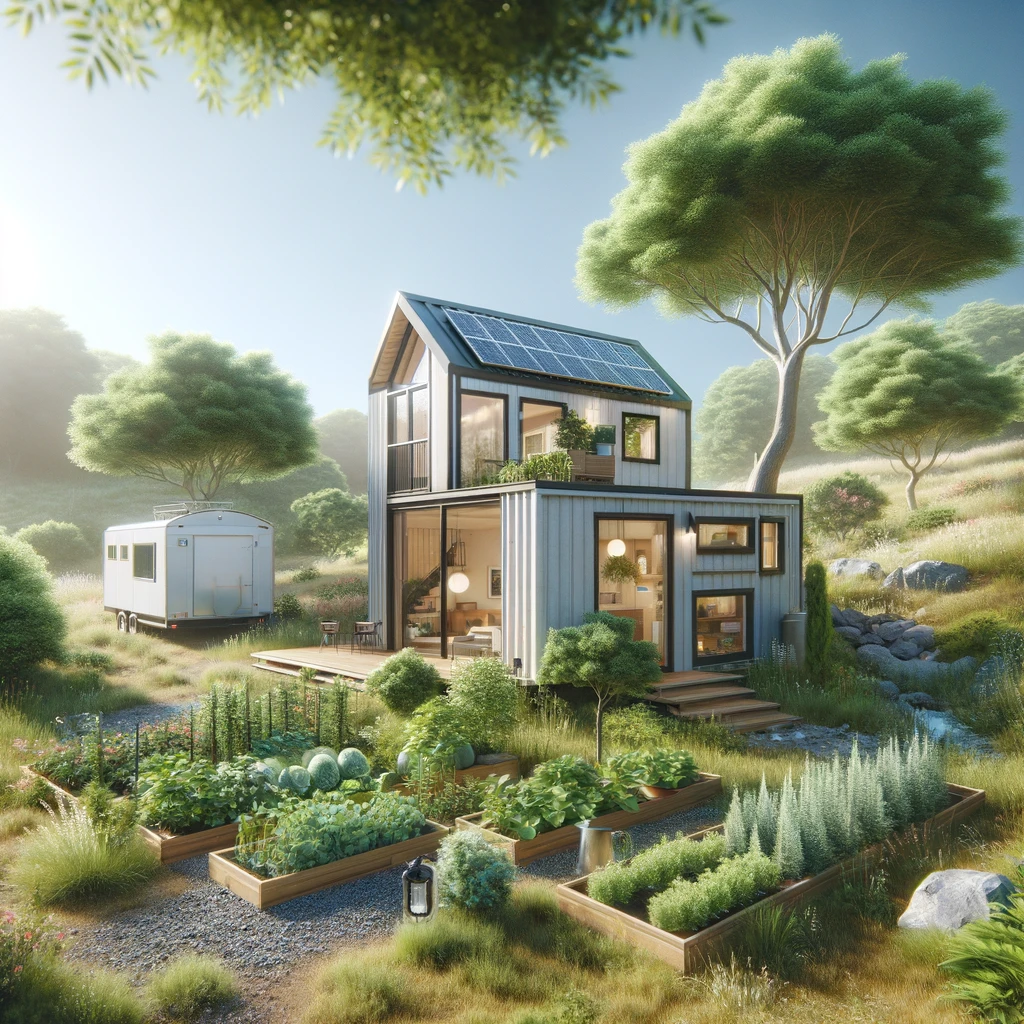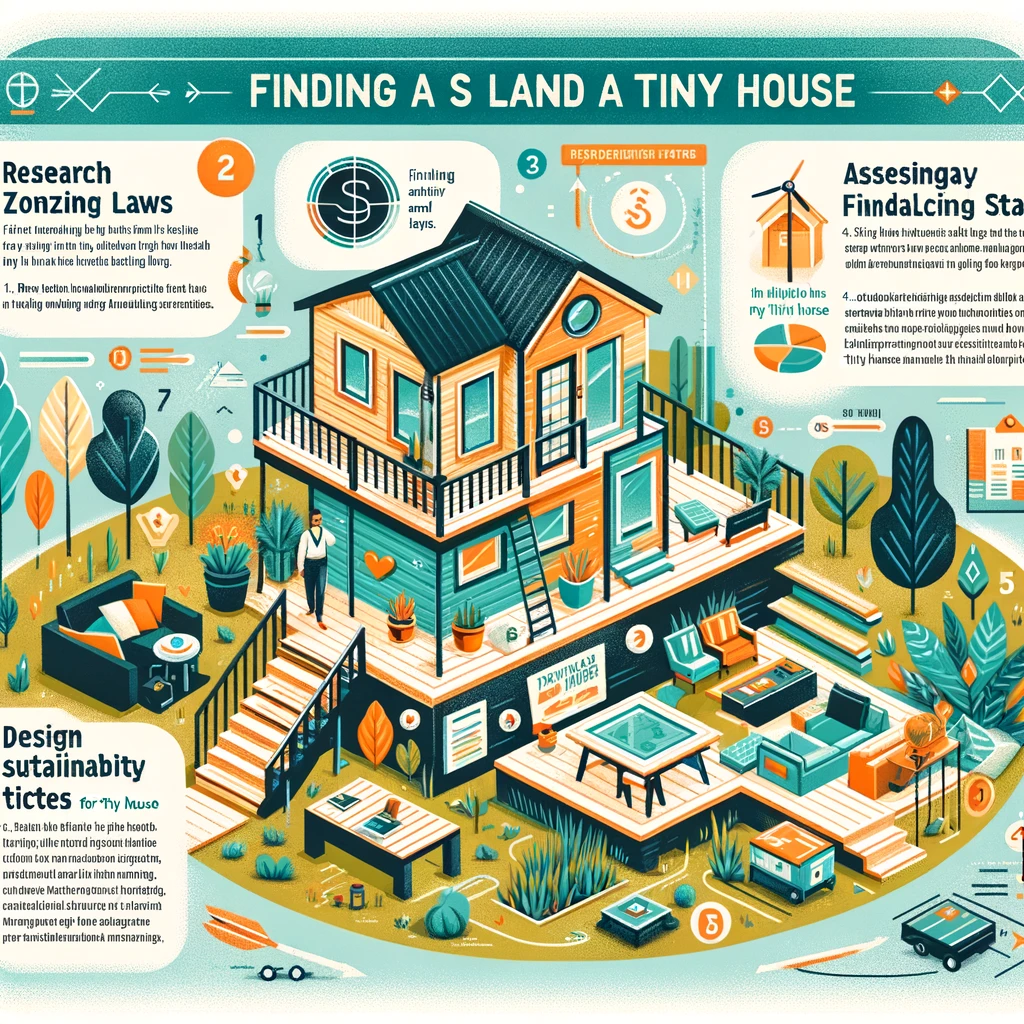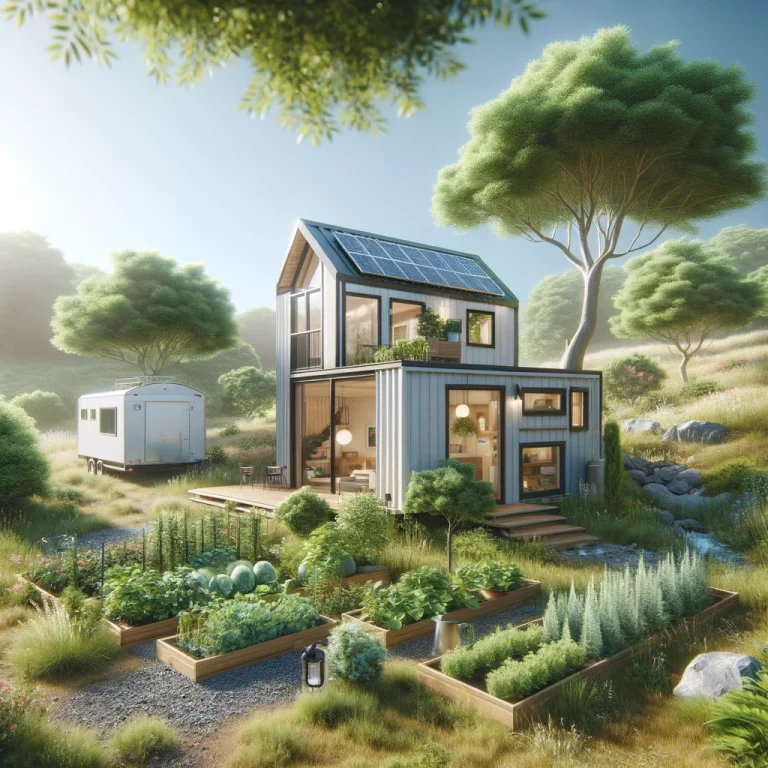

"Tiny Homes, Big Decisions: Navigating Land Acquisition for Your Small Living Dream"
1. Introduction
The charm of the tiny house movement is irresistible to many. But the most pressing question remains: where to place your dream tiny house? Determining the appropriate location is not a simple task, but with this comprehensive guide, you’ll gain valuable insights into navigating this journey successfully.
The tiny house movement has been exponentially expanding, captivating thousands worldwide. Its appeal lies in several aspects:
Simplified Living
Tiny houses represent a minimalist lifestyle, encouraging inhabitants to focus on essential living and discard the unnecessary.
Financial Freedom
They offer a cost-effective housing solution, reducing mortgage debt and freeing up income for other life aspirations.
Reduced Environmental Impact
Tiny homes, due to their size, naturally consume fewer resources and minimize the owner’s carbon footprint, thereby appealing to eco-conscious individuals.
2. Zoning Laws and Building Regulations in Detail
Embarking on your tiny house journey requires an understanding of the lay of the land, legally speaking. Zoning laws and building regulations are crucial aspects to consider when planning for a tiny home.
2.1 Zoning Laws
Zoning laws are the government’s way of managing urban development and growth. They categorize areas into residential, commercial, agricultural, and industrial zones. For example, an area zoned as “residential” can further be divided into single-family dwellings, multi-family dwellings, and yes, tiny houses. Some areas permit tiny houses without any restrictions, while others only allow them as auxiliary units. In some regions, they’re not allowed at all. Thus, understanding these laws is pivotal to your tiny house placement.
2.2 Building Regulations
Building regulations, on the other hand, set guidelines for the construction process. They dictate everything from minimum square footage, the number of exits, and ceiling height, to loft regulations. For instance, in some states, a tiny house on a foundation might be required to have at least one room of 120 square feet or more. Comprehending these regulations is essential to designing your tiny home.


3. The States Attracting the Most Tiny House Enthusiasts
Here are some states that have become popular among the tiny home community:
(Identifying the best places to build a tiny home requires in-depth knowledge of individual state regulations and receptiveness towards tiny living)
3.1 Oregon
Oregon is known for being exceptionally tiny-house-friendly, boasting a number of tiny house hotels for curious visitors to experience the lifestyle. Tiny houses on wheels are classified as “recreational vehicles” and tiny houses on a foundation are often classified as “accessory dwelling units” (ADUs).
Pros:
Mild weather for most of the year, which is ideal for tiny house living.
Lower crime rates compared to the national average.
Oregon has some top-rated school districts, making it a good place for families.
High quality of life with access to abundant outdoor activities and a strong focus on sustainability.
Cons:
Winters can be rainy and somewhat cold.
The cost of living can be high in certain areas.
3.2 Colorado
Colorado offers plenty of inspiration for potential tiny house dwellers with its stunning landscapes. Denver, Colorado has made significant strides to accommodate tiny house living, amending zoning codes to increase opportunities for ADUs and tiny home placement.
Pros:
Colorado has a dry, sunny climate, and is known for its outdoor recreational opportunities.
It boasts some highly-rated school districts.
A strong focus on health and wellness contributes to a high quality of life.
Cons:
Winters can be harsh with heavy snowfall.
Some areas have higher than average crime rates.
3.3 Texas
In Texas, cities like Austin are leading the way in creating tiny house-friendly zoning regulations. With a thriving arts scene and a booming economy, it’s a state that offers much to potential tiny house dwellers.
Pros:
Generally mild winters and plenty of sunshine throughout the year.
While crime rates vary, some areas have crime rates lower than the national average.
Texas has many excellent school districts.
A low cost of living and a booming economy contribute to a good quality of life.
Cons:
Summers can be extremely hot and humid.
Certain areas may have higher crime rates.
3.4 California
California is known for its progressive housing laws, with some cities offering pre-approved plans for ADUs to address the housing crisis.
Pros:
Mild, sunny climate for most of the year.
Some areas boast lower crime rates.
California is home to many highly-rated school districts.
High quality of life due to abundant job opportunities, outdoor activities, and cultural diversity.
Cons:
High cost of living.
Areas prone to wildfires and earthquakes.
3.5 Florida
In Florida, tiny house regulations often vary by county, but there are tiny house-friendly communities like Orlando Lakefront, a growing tiny house community in Orlando.
Pros:
Warm, sunny climate for most of the year.
Florida has many top-rated school districts.
Lower cost of living compared to many other states.
High quality of life due to plentiful outdoor activities and beautiful landscapes.
Cons:
High humidity and potential for hurricanes.
Some areas have higher crime rates.
4. Strategies for Locating the Perfect Tiny House Land
Unearthing the ideal plot for your tiny house requires careful planning and searching:
4.1 Criteria Evaluation
Define your preferences and requirements. This process involves careful contemplation of several factors:
Location: Determine the preferred setting for your tiny house. Are you inclined towards a serene rural setting or do you crave the hustle and bustle of city life? The proximity of the land to amenities such as markets, hospitals, and schools is also an important consideration.
Size and Cost of Land: The size of your tiny house will help guide the size of the land you need. Furthermore, evaluate your budget constraints. Remember, acquiring land is not the end of expenses – you will need to budget for potential costs of utilities, landscaping, and more.
Access to Utilities: Depending on how off-the-grid you want to be, access to utilities can be a significant factor. Does the land have easy access to water, electricity, and sewage systems? Or are you prepared for alternatives like solar power, compost toilets, and water collection systems?
Community Rules: If you’re considering a tiny house community, research the community rules. Some communities have specific requirements regarding the size and design of the houses. They might also have guidelines about shared responsibilities and community upkeep.
4.2 Broaden Your Search Horizon
Don’t restrict your search methods. Utilize every available resource:
Online Platforms: Websites such as Zillow, Realtor, and LandWatch provide comprehensive listings that you can filter according to your criteria.
Real Estate Agents: Local real estate agents can help provide insights into potential listings that might not be available or noticeable online.
Tiny House Communities: Many tiny house enthusiasts have formed communities, both virtual and physical. Online forums and social media groups can provide leads on available land. Visit tiny house shows, festivals, and meetups to connect with the community and gather valuable information.
Word of Mouth: Don’t underestimate the power of traditional networking. Friends, family, or even acquaintances may know of suitable plots available for purchase or lease.
Remember, finding the perfect land for your tiny house is a journey that requires patience, persistence, and thorough research. By considering the appropriate criteria and utilizing various resources, you can simplify the process and come closer to realizing your tiny house dream.
5. Tiny House Financing Options
Navigating the world of tiny house financing can be a bit of a puzzle. Traditional mortgage lenders often don’t cater to tiny homes, especially those on wheels. However, don’t lose heart, there are still plenty of avenues to explore.
Personal loans can be a great option for those seeking to finance their tiny house build. These loans typically don’t require collateral, making them ideal for tiny houses on wheels. Some credit unions and online lenders offer personal loans tailored specifically for tiny house financing.
RV loans are another viable option, especially for tiny houses built on trailers. Several institutions consider tiny houses on wheels as RVs and offer loans accordingly.
Finally, for DIY builders, home improvement loans or lines of credit can provide the funds needed to bring your tiny home to life.
6. Pros and Cons of Tiny House Living
As with any lifestyle choice, tiny house living has its ups and downs. Let’s dive into some of the pros and cons associated with this unique lifestyle:
Pros:
Financial Freedom: Tiny homes often cost less than traditional homes, allowing owners to live mortgage-free or reduce their debt.
Simplicity: Tiny living encourages a minimalist lifestyle, helping owners declutter and focus on what’s truly important.
Mobility: For tiny homes on wheels, the ability to travel and change scenery is a significant advantage.
Cons:
Limited Space: While many find the small space liberating, others may find it restrictive, especially those with large families or pets.
Zoning Laws: Navigating zoning laws and building codes can be challenging and varies significantly from place to place.
Social Perception: Tiny house living is still a relatively new concept, and not everyone understands or accepts it.
7. Sustainability and Tiny Homes
The ethos of the tiny house movement is deeply rooted in sustainability. Not only are tiny homes more energy-efficient due to their size, but their design and construction often utilize innovative sustainable solutions. Here are a few key areas where tiny homes excel in sustainability:
Construction Materials: The construction of a tiny home typically requires far fewer materials than a traditional house. Some enthusiasts even opt for reclaimed or recycled materials, which significantly reduces the environmental impact of the construction process.
Energy Efficiency: Due to their small size, tiny homes require less energy for heating and cooling. Many are also designed to maximize natural light, reducing the need for artificial lighting during the day.
Renewable Energy Sources: Many tiny homes are equipped with solar panels or wind turbines, allowing them to generate their own clean, renewable energy. This is not only good for the environment but can also result in significant savings on energy bills.
Water Conservation: Tiny homes often incorporate water-saving features, such as rainwater harvesting systems and greywater recycling systems. Composting toilets are also popular in tiny homes, reducing water usage and creating compost that can be used to nourish plants.
Waste Reduction: The minimalist lifestyle that comes with living in a tiny home often leads to reduced consumption, leading to less waste generation. Composting and recycling are also common practices in tiny house communities.
8. Design and Decoration Ideas for Tiny Homes
Designing a tiny home is all about maximizing the use of space while creating a cozy and inviting environment. Here are a few additional tips:
Use Vertical Space: When square footage is limited, think vertically. Install shelves and cabinets up to the ceiling to utilize all available space.
Incorporate Mirrors: Mirrors can make a small space feel larger by reflecting light and creating an illusion of depth.
Choose Convertible Furniture: Convertible furniture like sofa beds or expandable dining tables can transform one living space into another, providing more functionality.
Install a Skylight: Skylights not only provide natural light but can also make a tiny home feel more spacious.
Use Outdoor Space: Don’t forget to use the outdoor space. A small patio or deck with comfortable seating can serve as an extra living area.
Minimalism is Key: Keep decor and personal items to a minimum. This can make the home feel less cluttered and more spacious.
Remember, a well-designed tiny home can offer all the comfort and functionality of a full-size house. It just requires a little more creativity and smart planning. Happy designing!
9. Conclusion
Choosing where to build your tiny home involves a multitude of considerations, from understanding the zoning laws and building regulations to assessing the tiny house-friendliness of various states. But beyond these practicalities, this lifestyle shift also represents a significant step towards a more sustainable, minimalist, and financially liberating way of life.
From Oregon’s mild climate and progressive regulations to Texas’s booming economy and favorable tiny house zoning laws, each state offers unique advantages and challenges for tiny house dwellers. However, regardless of where you decide to settle down, keep in mind that tiny house living is not only about where your house is but also about what it represents – simplicity, freedom, and sustainability.
Financing a tiny house might seem challenging at first, but there are specific options available that cater to the unique needs of tiny homeowners. The movement towards tiny house living also presents a unique opportunity to lessen our environmental footprint, with many tiny homes incorporating sustainable features such as renewable energy sources and water conservation systems.
Designing your tiny home can be an exciting endeavor. With innovative design techniques and multifunctional furniture, these homes offer all the comfort and functionality of full-sized homes in a fraction of the space.
In conclusion, the journey to tiny house living may seem overwhelming, but with proper planning, research, and a little creativity, it can be an incredibly rewarding experience. Whether you’re drawn to the financial freedom, the minimalist lifestyle, or the environmental benefits, there’s no denying that tiny house living presents a compelling alternative to traditional housing. So why wait? Your tiny home adventure awaits!
10. FAQs
1. Can I build a tiny house anywhere?
Zoning laws and building regulations can limit where tiny homes can be placed. Always check with local authorities before purchasing land for a tiny house.
2. How can I learn about local zoning laws?
Contact your local zoning office or city hall for detailed information about zoning laws in your area. Laws can differ greatly between regions, so always confirm the details.
3. Which states are attracting the most tiny house enthusiasts?
Oregon, Colorado, Texas, California, and Florida are known for their popularity among the tiny house community, but always remember to conduct thorough research.
4. What is the average cost of land for a tiny house?
The cost of land can vary greatly depending on the location and size of the plot. Rural land can be significantly cheaper than land in urban areas. Always factor in the cost of land when planning your tiny house budget.
5. Do I need to consider access to utilities when choosing land for my tiny house?
Absolutely. Depending on your lifestyle, you’ll need to consider access to water, electricity, and sewage. Some tiny house owners choose off-grid options, but these also require planning and consideration.
6. Can I place my tiny house in someone else’s backyard?
This depends on the zoning laws of the area. Some places do allow tiny houses as accessory dwelling units (ADUs) in backyards. Always check local laws and regulations.
7. Are there tiny house communities where I can place my tiny house?
Yes, there are numerous tiny house communities across the U.S., offering plots of land specifically designed for tiny houses. These communities often come with shared amenities and a sense of community, making them a popular choice for many tiny house owners.
Remember, thorough research and careful planning are key when embarking on your tiny house journey.
Sources for this article include resources from the American Tiny House Association, Tumbleweed Tiny House Company, and personal interviews with tiny house owners
https://www.oregonlive.com/hg/2016/07/tiny_house_hotels.html ↩
https://abc30.com/realestate/city-of-fresno-leading-the-nation-in-tiny-home-living/3724622/ ↩
https://www.floridatoday.com/story/news/2017/07/21/tiny-houses-allowed-brevard-county/491645001/ ↩

